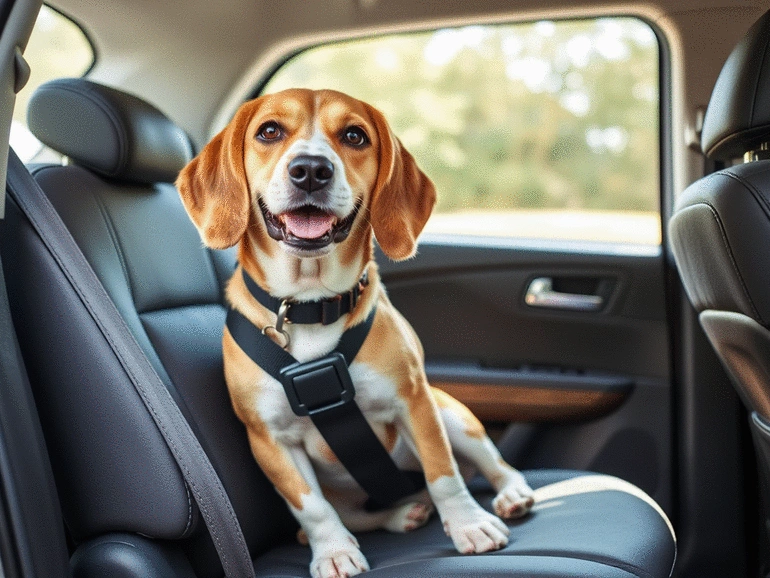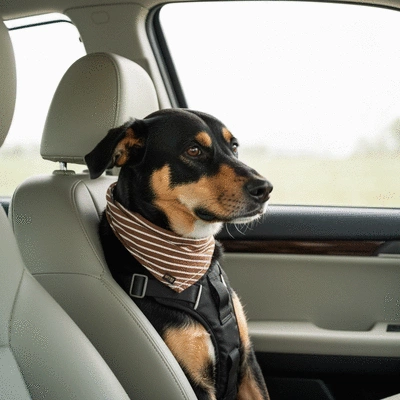Why Dog Safety in Cars Matters
- Prevents pet injuries during sudden stops or collisions.
- Minimizes risk of distractions while driving.
- Provides peace of mind for pet owners.

Have you ever wondered how to keep your furry friend safe during car rides? As a responsible pet owner, understanding the importance of using a dog seat belt can make all the difference. Let's explore the key insights you need for safer travels with your pup!
Prioritizing your dog's safety in the car involves understanding the importance of proper restraints, accurate sizing for seat belts, and the benefits of crash-tested options. The visual below details these critical aspects to ensure a safe and comfortable journey for your canine companion.
As a passionate advocate for pet safety, I can’t stress enough how crucial it is to think about dog safety in cars. Picture this: you're driving with your furry friend happily sitting next to you, but suddenly, you hit the brakes. Without a proper restraint, your beloved companion could be at risk. This scenario highlights why every pet owner must prioritize using dog seat belts during car travel.

Not only do dog seat belts help protect your pet in the event of sudden stops, but they also keep them from becoming a distraction while driving. By securing your dog, you’re ensuring a safer environment for both of you. Now, let’s dive deeper into why dog safety matters.
When it comes to traveling with our dogs, their safety should always be the top priority. According to various studies, unrestrained pets can be severely injured during accidents, not to mention they pose a danger to drivers and passengers. For additional insights on pet safety during travel, you can refer to resources like The Car Seat Lady's guide on pet restraints. Here are some key reasons why you should consider dog seat belts:
By investing in a quality dog seat belt, you’re taking the first step toward a safer travel experience. It’s not just about following the rules; it’s about making responsible choices for your pet's well-being!
Utilizing a dog seat belt comes with a host of benefits that enhance your travel experience. Here’s what you can gain:
With these benefits, it’s clear that a dog seat belt is an essential travel accessory for any pet owner. So, are you ready to keep your pup safe and secure?
Not all dog seat belts are created equal, and that's where crash-tested options come in. Crash-tested dog seat belts undergo rigorous safety evaluations to ensure they can withstand the impact of a collision. Here’s why this is critical:
As the founder of Dog Seat Belts, I highly recommend only choosing crash-tested options. After all, our pets deserve the very best when it comes to safety, especially during car rides!
Here's a brief recap of the key points discussed so far:
Finding the right dog seat belt for your furry friend starts with accurate measurements. Just like we wouldn’t wear a pair of shoes that don’t fit, our pets deserve the same consideration when it comes to their safety gear! Let’s take a closer look at how you can ensure your dog is perfectly fitted for their seat belt.

Measuring your dog accurately is crucial for both comfort and safety. You'll need a flexible measuring tape to get started. Follow these simple steps:
Record these measurements to help you choose the right size. Remember, a snug fit is important, but it shouldn’t be too tight—your dog should be able to move comfortably!
Even with accurate measurements, sizing issues can arise. Here are a few common problems and how to tackle them:
Being aware of these potential issues can save you time and frustration! It's all about ensuring your dog is safe and comfortable during car rides.
Not all dogs are created equal, and that’s why size categories are essential when choosing a dog seat belt. Here’s a quick guide:
Understanding these categories helps you make informed choices and ensures that every pup, big or small, can travel safely! Now that you know how to measure your dog, let’s move on to exploring the various types of dog seat belts and harnesses available.
Here are some common questions about dog seat belts and their importance:
Here is a quick recap of the important points discussed in the article:
Dedicated to enhancing pet safety during car travel, we provide comprehensive reviews, installation guides, and essential tips for responsible pet owners. Join us in making every journey safe and enjoyable for your furry friend.
